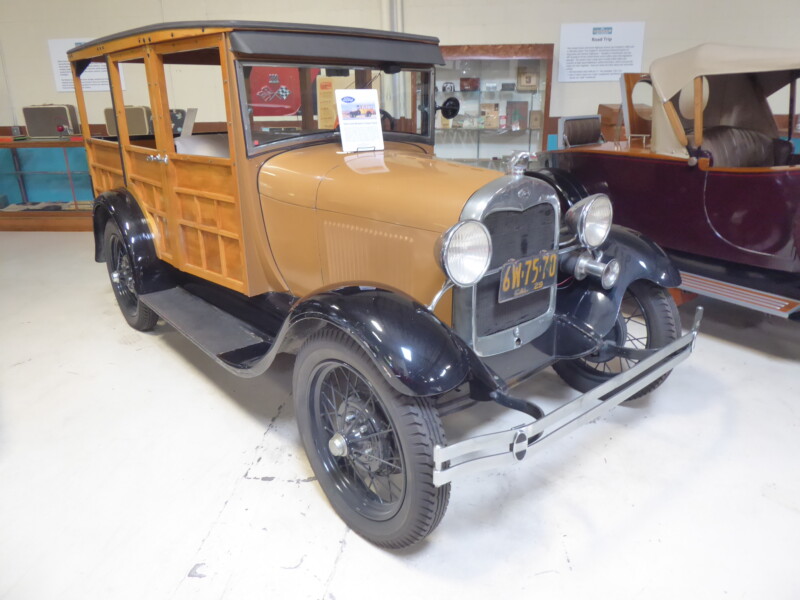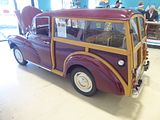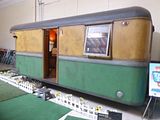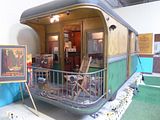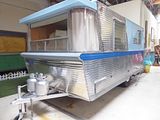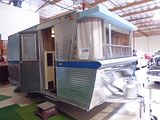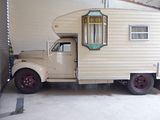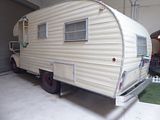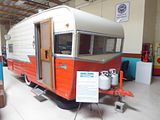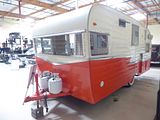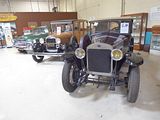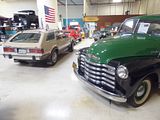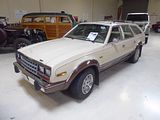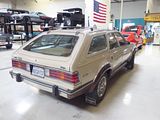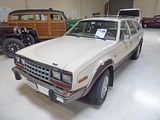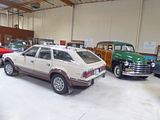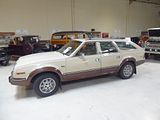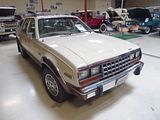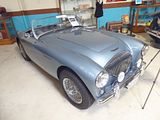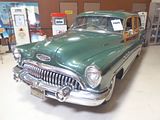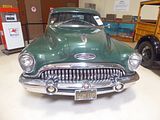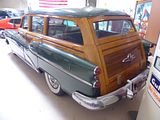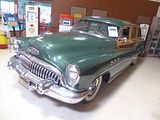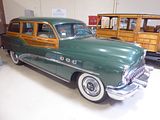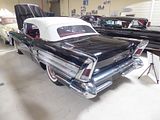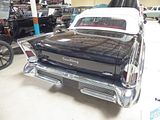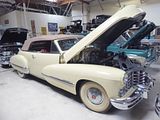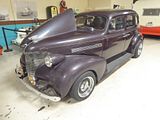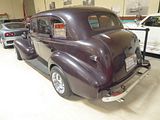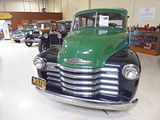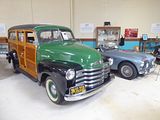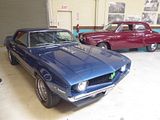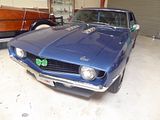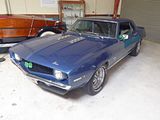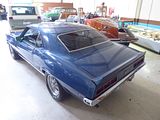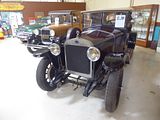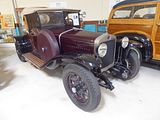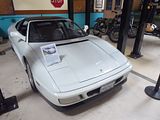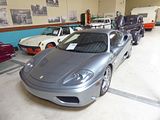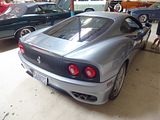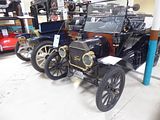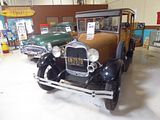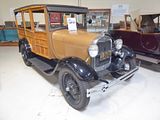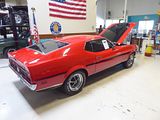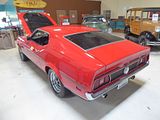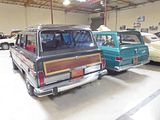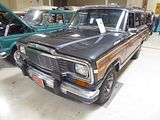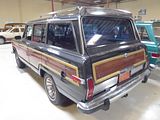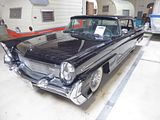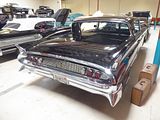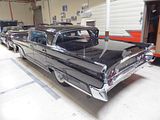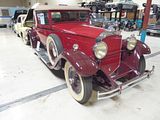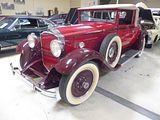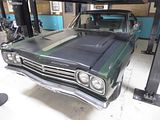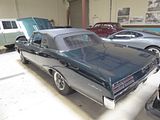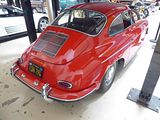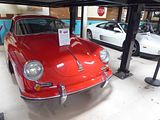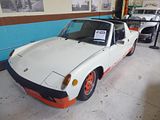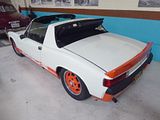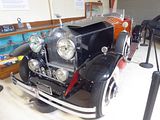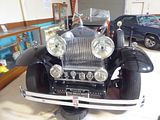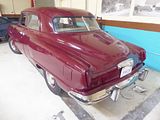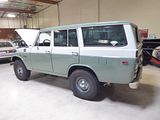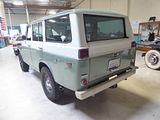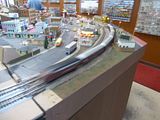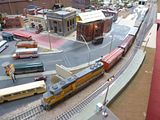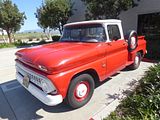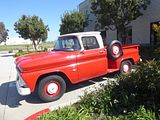Oxnard is one of those towns in the Greater Los Angeles area that anyone driving north on the 101 freeway will have heard of, but probably never bothered to go and explore. And that’s quite understandable, as there is nothing to suggest that there is a lot to interest the tourist there whereas if you go a few miles further you reach Ventura and the Pacific coast. But it does boast two car museums. The better known of them, these days, is the Mullin Collection, a treasure trove of 1930s French elegance, and other cars collected by Peter Mullin and his wife over many years. There’s another one, which has actually been open for quite a bit longer, called the Murphy Collection, also founded by the enthusiasm of one man, the late Dan Murphy, a neuro-surgeon by profession, who wanted others to be able to enjoy the cars that he had collected by opening a museum to house them. I last went to this back in 2008, and found a diverse collection of cars which kept me entertained for long enough to feel that the trek along the 101 and back had been worthwhile. I decided that 15 years on, it was time to go and see what had changed. And the answer proved to be just about everything apart from the name! For a start, the museum has moved. It turned out that the landlord of the previous site forced that upon the museum a few years ago and they did manage to find new premises elsewhere in Oxnard, though it has to say that the inside of the building does not really look as finished as the previous one had done. Further discussion with the museum staff elicited that most of the cars on display are loaned, and do change fairly regularly, so what I saw were a few cars that were there last time and several that were not. Read on!
In the foyer, there is a car you probably don’t expect to see in the US at all, a Morris Minor Traveller: The Minor was conceived in 1941. Although the Nuffield Organization was heavily involved in war work and there was a governmental ban on civilian car production, Morris Motors’ vice chairman, Miles Thomas, wanted to prepare the ground for new products to be launched as soon as the war was over. Vic Oak, the company’s chief engineer, had already brought to Thomas’ attention a promising junior engineer, Alec Issigonis, who had been employed at Morris since 1935 and specialised in suspension design but he had frequently impressed Oak with his advanced ideas about car design in general. Issigonis had come to Oak’s particular attention with his work on the new Morris Ten, which was in development during 1936/7. This was the first Morris to use unitary construction and was conceived with independent front suspension. Issigonis designed a coil-sprung wishbone system which was later dropped on cost grounds. Although the design would later be used on the MG Y-type and many other post-war MGs the Morris Ten entered production with a front beam axle. Despite his brief being to focus on the Ten’s suspension Issigonis had also drawn up a rack and pinion steering system for the car. Like his suspension design this was not adopted but would resurface in the post-war years on the MG Y-type, but these ideas proved that he was the perfect candidate to lead the design work on a new advanced small car. With virtually all resources required for the war effort, Thomas nonetheless approved the development of a new small family car that would replace the Morris Eight. Although Oak (and Morris’ technical director, Sidney Smith) were in overall charge of the project it was Issigonis who was ultimately responsible for the design, working with only two other draughtsmen. Thomas named the project ‘Mosquito’ and ensured that it remained as secret as possible, both from the Ministry of Supply and from company founder William Morris (now Lord Nuffield), who was still chairman of Morris Motors and, it was widely expected, would not look favourably on Issigonis’ radical ideas. Issigonis’ overall concept was to produce a practical, economical and affordable car for the general public that would equal, if not surpass, the convenience and design quality of a more expensive car. In later years he summed up his approach to the Minor; that he wanted to design an economy car that “the average man would take pleasure in owning, rather than feeling of it as something he’d been sentenced to” and “people who drive small cars are the same size as those who drive large cars and they should not be expected to put up with claustrophobic interiors.” Issigonis wanted the car to be as spacious as possible for its size and comfortable to drive for inexperienced motorists. Just as he would with the Mini ten years later, he designed the Mosquito with excellent roadholding and accurate, quick steering not with any pretence of making a sports car, but to make it safe and easy to drive by all. As work proceeded, there were plenty of battle to overcome, to get Issigonis’ ideas approved, and not all of them were. The production car, called the Minor was launched at the British Motor Show at Earls Court in London on October 27, 1948. At the same show Morris also launched the new Morris Oxford and Morris Six models, plus Wolseley variants of both cars, which were scaled-up versions of the new Minor, incorporating all the same features and designed with Issigonis’ input under Vic Oak’s supervision. Thus Issigonis’ ideas and design principles underpinned the complete post-war Morris and Wolseley car ranges. The original Minor MM series was produced from 1948 until 1953. It included a pair of four-seat saloons, two-door and (from 1950) a four-door, and a convertible four-seat Tourer. The front torsion bar suspension was shared with the larger Morris Oxford MO, as was the almost-unibody construction. Although the Minor was originally designed to accept a flat-4 engine, late in the development stage it was replaced by a 918 cc side-valve inline-four engine, little changed from that fitted in the 1935 Morris 8, and producing 27.5 hp and 39 lb/ft of torque. This little engine pushed the Minor to just 64 mph but delivered 40 mpg. Brakes were four-wheel drums. Early cars had a painted section in the centre of the bumpers to cover the widening of the production car from the prototypes. This widening of 4 inches is also visible in the creases in the bonnet. Exports to the United States began in 1949 with the headlamps removed from within the grille surround to be mounted higher on the wings to meet local safety requirements. In 1950 a four-door version was released, initially available only for export, and featuring from the start the headlamps faired into the wings rather than set lower down on either side of the grille. The raised headlight position became standard on all Minors in time for 1951. From the start, the Minor had semaphore-type turn indicators, and subsequent Minor versions persisted with these until 1961 An Autocar magazine road test in 1950 reported that these were “not of the usual self-cancelling type, but incorporate[d] a time-basis return mechanism in a switch below the facia, in front of the driver”. It was all too easy for a passenger hurriedly emerging from the front passenger seat to collide with and snap off a tardy indicator “flipper” that was still sticking out of the B-pillar, having not yet been safely returned by the time-basis return mechanism to its folded position. Another innovation towards the end of 1950 was a water pump (replacing a gravity dependent system), which permitted the manufacturer to offer an interior heater “as optional equipment”. When production of the first series ended, just over a quarter of a million had been sold, 30 per cent of them the convertible Tourer model. In 1952, the Minor line was updated with an Austin-designed 803 cc overhead valve A-series engine, replacing the original side-valve unit. The engine had been designed for the Minor’s main competition, the Austin A30, but became available as Austin and Morris were merged into the British Motor Corporation. The new engine felt stronger, though all measurements were smaller than the old. The 52 second drive to 60 mph was still calm, with 63 mph as the top speed. Fuel consumption also rose to 36 mpg. An estate version was introduced in 1952, known as the Traveller (a Morris naming tradition for estates, also seen on the Mini). The Traveller featured an external structural ash (wood) frame for the rear bodywork, with two side-hinged rear doors. The frame was varnished rather than painted and a highly visible feature of the body style. Commercial models, marketed as the Morris Quarter Ton Van and Pick-up were added in May 1953. Rear bodies of the van versions were all steel. The 4-seat convertible and saloon variants continued as well. The car was again updated in 1956 when the engine was increased in capacity to 948 cc. The two-piece split windscreen was replaced with a curved one-piece one and the rear window was enlarged. In 1961 the semaphore-style trafficators were replaced by the flashing direction indicators, these were US-style red at the rear (using the same bulb filament as the brake lamp) and white at the front (using a second brighter filament in the parking lamp bulb) which was legal in the UK and many export markets at the time (such as New Zealand). An upmarket car based on the Minor floorpan using the larger BMC B-Series engine was sold as the Riley One-Point-Five/Wolseley 1500 beginning in 1957: versions of this Wolseley/Riley variant were also produced by BMC Australia as the Morris Major and the Austin Lancer. In December 1960 the Morris Minor became the first British car to sell more than 1,000,000 units. To commemorate the achievement, a limited edition of 350 two-door Minor saloons (one for each UK Morris dealership) was produced with distinctive lilac paintwork and a white interior. Also the badge name on the side of the bonnet was modified to read “Minor 1,000,000” instead of the standard “Minor 1000”. The millionth Minor was donated to the National Union of Journalists, who planned to use it as a prize in a competition in aid of the union’s Widow and Orphan Fund. The company, at the same time, presented a celebratory Minor to London’s Great Ormond Street Hospital for Sick Children, but this car was constructed of cake.The final major upgrades to the Minor were made in 1962. Although the name Minor 1000 was retained, the changes were sufficient for the new model to be given its own ADO development number. A larger version of the existing A-Series engine had been developed in conjunction with cylinder head specialist Harry Weslake for the then new ADO16 Austin/Morris 1100 range. This new engine used a taller block than did the 948 cc unit, with increased bore and stroke bringing total capacity up to 1,098 cc. Although fuel consumption suffered moderately at 38 mpg, the Minor’s top speed increased to 77 mph with noticeable improvements in low-end torque, giving an altogether more responsive drive. Other changes included a modified dashboard layout with toggle switches, textured steel instrument binnacle, and larger convex glove box covers. A different heater completed the interior upgrade, whilst the larger combined front side/indicator light units, common to many BMC vehicles of the time, were fitted to the front wings. These now included a separate bulb and amber lens for indicators while larger tail lamp units also included amber rear flashers. During the life of the Minor 1000 model, production declined. The last Convertible/Tourer was manufactured on 18 August 1969, and the saloon models were discontinued the following year. Production of the more practical Traveller and commercial versions ceased in 1972, although examples of all models were still theoretically available from dealers with a surplus of unsold cars for a short time afterwards. 1,619,857 Minors of all variants were ultimately sold.
Following the guidance on the route to take around the museum, the first displays are not actually cars at all, but what we would think of as historic caravans.
1927 – 35 Holt Travel Trailor
1960 Holiday House Travel Trailor
1948 Studebaker “Big Ugly”: This big boy affectionately known as “Big Ugly” was donated to the Murphy Auto Museum in May 2021. The donee purchased this 2 ton Studebaker truck, with a home built camper, for $500.00 at age 18 in 1965 from the original old man owner. The original owner of the truck had built the camper. The eighteen year old took it on a voyage across country and to Mexico for surf trips as well as his honeymoon! When he went off to college, his dad “repossessed” the truck and started improving it. A tinkerer and fixer by nature, the dad upgraded the rig with genuine stained glass bay windows, a mahogany interior, orange enamelled wood stove, Blaupunkt stereo tape deck, bucket seats in the cab and a Chevrolet V8 engine. He and Anne, his lady friend, spent the next 4 decades traveling the country at every chance. When the dad passed away at the age of 98, the truck went back to the son. He is now in his seventies, and is the one who donated the truck to the museum. The truck has a vanity plate of BIG UGLY, an endearing name and one of the first vanity plates issued in California.
1960 Shasta de Luxe
And then you do get to the cars. There are around 40 to 50 cars on display at any one time, representing the core of the permanent collection and cars that are on temporary loan. Most of them are from US marques, and they range from the familiar to ones you may not have heard of at all. Many of them are not that easy to photograph and the bonnets on a lot of them were raised, making further photography challenges.
1985 AMC Eagle 4WD: The AMC Eagle is a compact four-wheel drive passenger vehicle manufactured and marketed in a single generation by American Motors Corporation (AMC) for model years 1980 through 1987 and continued by Chrysler Corporation following its acquisition of AMC in 1987, for the 1988 model year. Introduced in August 1979 for the 1980 model year, the coupe, sedan, and station wagon body styles were based on the AMC Concord. In 1981, the two-door subcompact-sized AMC Spirit-based models, the SX/4 and Kammback, joined the Eagle line aimed at both first-time buyers and fleet sales. A Sundancer convertible conversion for the larger Eagle two-door model was available during 1981 and 1982. By 1984, only sedan and station wagon versions were available. For 1988, its final model year, only a station wagon was offered, which was marketed as the “Eagle Wagon”. However, the name continued to be used by Chrysler Corporation as the Eagle brand of cars through 1998. The AMC Eagles were the only four-wheel drive passenger cars produced in the United States at the time. All models featured “passenger-car comfort, plus 4WD security for all-weather security.” Marketing materials of the time refer to the Eagle as a “vehicle,” “automobile,” “car,” or “sport machine.” Although the description was not in use at the time, the AMC Eagle is widely recognized as the first crossover vehicle.
1956 Austin-Healey 100 BN2: Donald Healey had been producing a range of expensive sports cars from the 1940s, cars such as the Silverstone, the Abbott and the Farnham. For the 1952 London Motor Show, he produced a new design, which was called the Healey Hundred, based on Austin A90 mechanicals, which he intended to produce in-house at his small car company in Warwick. It was one of the stars of the 1952 Show, and it so impressed Leonard Lord, the Managing Director of Austin, who was looking for a replacement to the unsuccessful A90. that Lord struck a deal with Healey on the spot, to build it in quantity. Bodies made by Jensen Motors would be given Austin mechanical components at Austin’s Longbridge factory. The car was renamed the Austin-Healey 100, in reference to the fact that the car had a top speed of 100 mph. Production got under way in 1953, with Austin-Healey 100s being finished at Austin’s Longbridge plant alongside the A90 and based on fully trimmed and painted body/chassis units produced by Jensen in West Bromwich—in an arrangement the two companies previously had explored with the Austin A40 Sports. By early 1956, production was running at 200 cars a month, 150 of which were being sold in California. Between 1953 and 1956, 14,634 Austin-Healey 100s were produced, the vast majority of them, as was the case for most cars in this post war era, going for export. The car was replaced by an updated model in 1956, called the 100-6. It had a longer wheelbase, redesigned bodywork with an oval shaped grille, a fixed windscreen and two occasional seats added (which in 1958 became an option with the introduction of the two-seat BN6 produced in parallel with the 2+2 BN4), and the engine was replaced by one based on the six-cylinder BMC C-Series engine. In 1959, the engine capacity was increased from 2.6 to 2.9 litres and the car renamed the Austin-Healey 3000. Both 2-seat and 2+2 variants were offered. It continued in this form until production ceased in late 1967. The Big Healey, as the car became known after the 1958 launch of the much smaller Austin-Healey Sprite, is a popular classic now. You come across the 3000 models more frequently than the 100s, as they accounted for more than 60% of all Big Healey production
1953 Buick SupeWagon: The Super shared a new General Motors C-body with the Roadmaster but on a shorter wheelbase. It featured three chrome VentiPorts on each front fender to denote its smaller displacement straight-eight engine when compared with the Roadmaster. The sales brochure noted that VentiPorts helped ventilate the engine compartment, and possibly that was true in early 1949, but sometime during the model year they became plugged. The idea for VentiPorts grew out of a modification Buick styling chief Ned Nickles had added to his own 1948 Roadmaster. He had installed four amber lights on each side of his car’s hood wired to the distributor so as to flash on and off as each piston fired simulating the flames from the exhaust stack of a fighter airplane. Combined with the gunsight mascot hood ornament, VentiPorts put the driver at the controls of an imaginary fighter airplane. Upon seeing this, Buick chief Harlow Curtice was so delighted that he ordered that (non-lighting) VentiPorts be installed on all 1949 Buicks. “Super” script was found just above the full length body fender moulding on the front fenders. New fender edge taillamps were featured while rear fender skins remained a Buick standard. New fender top parking lamps, harkening back to 1941 styling appeared. Full wheel trim discs were standard along with such features as a cigar lighter, ashtray, and automatic choke. Cloth interiors were standard, except on the convertible which was trimmed in leather and leatherette and had a power top, seat and windows as standard equipment. Dynaflow automatic transmission was now optional equipment on Supers in 1949. Cars so equipped had 6.9:1 compression ratio and 120 horsepower. Total sales set a record at 190,514 for the first time since the Super’s introductory year. The instrument panel was new. The 1950 Supers shared with all the other series totally new all bumper guard grille and more rounded styling. Super script appeared on front fenders just above the full length lower bodyside mouldings. A new body style was a 2-door Riviera hardtop. Another new bodystyle was a long wheelbase sedan which was stretched an extra four inches (102 mm) and featured plusher interior than most Supers, which normally had cloth interiors of finer material than the Special. Supers had three VentiPorts on each hoodside. The convertible had leather power seats plus power windows and top. The 1950 Super came with a single two-barrel carburetor on a new higher displacement 263 cu in (4.3 L) Fireball I8 which produced 112 hp. It was able to achieve speeds over 90 miles per hour (140 km/h) with an optional Dynaflow automatic transmission which, rather than changing through gears, used the torque converter to couple the motor to a single gear ratio. The car had two splits in the back glass although the windshield was now curved one-piece glass. Models also could be equipped with an AM radio and an antenna that could be adjusted via a knob in the front centre above the windshield. In the June 1953 Popular Mechanics, acceleration was rated at 0-60 mph in 14.5 seconds due to the languid nature of the Dynaflow transmission. The Super set an all time record of 251,883 sold. In 1951 Supers had larger bodies than Specials but looked similar with three rounded VentiPorts per fender, broad bright fender shields and a full length “Sweepspear” chrome body side moulding. This chrome-plated strip started above the front wheel, after which it gently curved down nearly to the rocker panel just before the rear wheel, and then curved around the rear wheel in a quarter of a circle to go straight back to the taillight. Series script was found on the deck lid and within the steering wheel center. The long wheelbase sedan was named the Riviera sedan although it was not a hardtop. Supers were trimmed with materials similar to Special Deluxes except for in the plush Super Riviera sedan. Front turn signals were within the bumper guard “bombs,” while rear signals shared the stop lamps’ housing on the rear fender edges. The convertibles and Estate wagon were trimmed in leather. 169,226 Supers were sold. In 1952 Buick’s mid-priced line resembled the Series 40 with three VentiPorts per fender and Sweepspear rocker panel trim. Super script appeared on the rear fenders aided identification. The Super was built with the larger C-body, however. The full flowing fenderline dipped deeper on this body and rear fenders had a rear crest line absent on the B-body Specials. A new deck lid gave a more squared off appearance. Like other Buick series it was a near copy year for 1952. Chromed rear fender fins gave distinction to 1952 Supers. Interiors were cloth except on convertibles and Estate wagons which were trimmed with leather. The Super used a different instrument panel than the Special. It was distinguished by a large centre speedometer housing flanked by smaller gauge housings. Series identification was found within the steering wheel center. The Sedanet and the regular wheelbase sedan were cancelled. Sales fell to 135,332. In 1953 Buick’s middle priced line shared the Roadmaster’s new V8 and, for this year the Roadmaster shared the Super and Special’s 121.5 in (3,086 mm) wheelbase. The Super earned a horizontal trim bar on its rear fenders which distinguished it from the Series 70 Roadmasters. Otherwise its side trim bar on its rear fenders was identical although the Super was had only three VentiPorts on each front fender. Series identification was found on the deck emblem. Full wheelcovers were now standard. The vee in the bombsight ornament signified the V8 power under the hood. Interiors in most models were nylon and silky broadcloth. The convertible had power windows, seat and top as standard equipment. Dynaflow was now standard equipment. Air conditioning was a new option. A total of 190,514 Supers were sold.
1958 Buick Century Convertible: For 1954, Buick reintroduced the Century using the same formula of mating the smaller, lighter Buick Special body to its largest and most powerful 322 cu in (5.3 L) “Fireball” OHV V8 engine mated with a Dynaflow automatic transmission, with the intent of giving Buick a performance vehicle. Included in the model lineup during this period was a station wagon model, a body style that had been unavailable during the Century’s first production period of 1936 until 1942. In 1953 The Buick-Berle Show introduced product placement commercials on TV, and later in 1955 The Honeymooners was one of the sponsors. Introduced in the middle of the 1955 model year, the four-door Buick Century Riviera along with the four-door Special Riviera, the four-door Oldsmobile 98 Holiday, and four-door 88 Holiday, were the first four-door hardtops ever produced. For the first time, the Century was repositioned below the C-body Buick Super and priced lower. It continued to feature four “VentiPorts” on the front fenders like the larger Buick Roadmaster indicating its status equal to the Super, denoting it was a junior level Buick using the shorter B-body. It also introduced the “Panoramic” one-piece wrap around windshield on all GM cars for 1955. In 1955, the California Highway Patrol placed a large fleet order for 270 Century two-door sedans, a body style unavailable to the general public. It combined the Special two-door sedan body shell with Century powertrain, of which 135 were Dynaflow automatics and 135 were manual transmissions. Broderick Crawford was shown driving a two-door Century sedan during the first season of his popular syndicated TV series Highway Patrol. These Century two-door sedans were actual police vehicles owned by the California Highway Patrol and were loaned to the TV production company, the CHP door emblems were changed to a generic highway patrol emblem. (In later seasons, he drove a four-door Century but these were not California Highway Patrol owned vehicles.) Power brakes were optional. Tubeless tires were new. The Century remained Buick’s performance line, with engine power rising from 200 hp (SAE gross) in 1954, to 236 hp in 1955, to 255 hp in 1956, and topping out at 300 hp from a bored-out 364 cu in (6.0 L) engine in 1957 and 1958, the last model years for the full-sized Century line. In 1956, the Century’s base price was US$2,963. Power windows were standard in the convertible. A padded safety dash became optional. For 1957, Buick styling was notable for its three-piece rear window design. This was a feature in all series fixed-roof body-styles, (excluding wagons and convertibles). Oldsmobile also used this 3-piece rear window design that year, marketed as the “Twin-Strutted Rear Window.” Because the Century was considered the senior “small Buick”, the model received a version of GM’s hardtop station wagon, the Century Caballero Estate for the 1957 and 1958 model years and was not continued for 1959. For 1959, Buick renamed the Century the Invicta.
1946 Cadillac 62 Convertible: The first postwar Cadillac rolled off the line on October 7, 1945, and for several months, only Series 62s were produced. 1946 Cadillacs were not significantly altered from 1942 outside a few styling changes and the addition of a negative ground battery. The Series 62 retained the same lineup of body styles as in 1942—coupe, sedan, and convertible, and 18,565 total were produced for the model year, approximately 65% of Cadillac’s total 1946 output of 29,000 vehicles. Resuming civilian production was a difficult task for the entire automobile industry and demand for new cars much exceeded supply. Cadillac had as many as 100,000 unfilled orders into 1947. Due to materials shortages, some Cadillacs shipped from the factory with wooden bumpers, dealers being expected to install proper ones as they became available. Postwar inflation pushed the sticker price of a 1946 Cadillac over $1000 higher than 1942. In 1946, the Series 62 used GM’s C-body platform, as did the Cadillac Sixty Special, Buick Super and Buick Roadmaster, and Oldsmobile 98. Notchback styling characterized the cars except for the Club Coupe which had fastback styling. It was easy to distinguish the Series 62 coupe from the Series 61 because the door skins did not flare out above the rocker panel moldings, and the side window openings were lower and the reveal window mouldings circled each window individually instead of looping around all the windows. The Series 62 sedan featured ventiplanes on both the front and rear door windows. It was also the first Cadillac to enter production after World War II. Interior styling and technical features were similar to those seen on the Cadillac Series 61 but with slightly richer interior appointments. Late 1946 models introduced technical changes to the V8 engine in the form of hardened ball seats for the hydraulic lifters. The 1947 models received minor styling changes and the addition of Hydro-Lectric window lifts on the Series 62 convertible, which remained the sole ragtop in Cadillac’s lineup. Polished metal stone guards on the fenders replaced the rubber ones used on 1946 models. As before, Series 62s remained Cadillac’s bread-and-butter lineup with 39,834 produced, 84% of the make’s total 1947 volume. The first all-new postwar Cadillacs arrived in 1948.
1939 Chevrolet Master de Luxe: The Chevrolet Master and Master Deluxe are American passenger vehicles manufactured by Chevrolet between 1933 and 1942 to replace the 1933 Master Eagle. It was the more expensive model in the Chevrolet range at this time, with the Standard Mercury providing an affordable product between 1933 and 1937. Starting with this generation, all GM cars shared a corporate appearance as a result of the Art and Color Section headed by Harley Earl. From 1940 a more expensive version based on the Master Deluxe was launched called the Special Deluxe. The updated corporate appearance introduced a concealed radiator behind a façade with a grille. This was the last Chevrolet that was exported to Japan in knock down kits and assembled at the company’s factory in Osaka, Japan before the factory was appropriated by the Imperial Japanese Government. When Toyota decided to develop their own sedan called the Toyota AA, a locally manufactured Master was disassembled and examined to determine how Toyota should engineer their own cars. In May of 1925 the Chevrolet Export Boxing plant at Bloomfield, New Jersey was repurposed from a previous owner where Knock-down kits for Chevrolet, Pontiac, Oldsmobile, Buick and Cadillac passenger cars, and both Chevrolet and G. M. C. truck parts are crated and shipped by railroad to the docks at Weehawken, New Jersey for overseas GM assembly factories. The Master name was used on a number of different versions, and the Series name changed each year. A four door open top convertible was no longer offered starting in 1933. The 1933 Series CA began production as the “Eagle”, but was renamed “Master” midway through the model year when the 1933 Standard model (Series CC) was introduced. Several changes were made to the Eagle when the name was changed to Master. The easiest to distinguishing feature is the post between the front door wing windows and the roll down windows: on the Eagle the chrome divider between these two windows goes down as the window goes down, whereas on the Master this divider remains fixed and does not go down with the window. In 1934 the Series DA Master offered an increased wheelbase of 112 in (2,844.8 mm). This increased the difference with the cheaper Standard wheelbase to 5 in (127.0 mm). Powered by an upgraded version of the 206 cu in (3,380 cc) “Stovebolt” six-cylinder engine, now producing 80 hp. The independent front suspension was something GM called “Knee-Action” using trailing arms and coil springs. In 1935, the Master underwent a redesign, utilising a new “Turret Top” construction method. This consisted of steel used entirely in the body construction to include the roof and wood was no longer used in bodywork or chassis construction. For 1936, with the Series FA and FD, all Chevrolet took on an upgraded streamlined appearance as Chevrolet sought to take on a new and modern appearance called Art Deco, and the bodies were shared with the Pontiac Deluxe.. In 1937. with the Series GA and GB, the Master now replaced the lower priced Standard Six, while the higher equipment Master Deluxe edged the range upwards. While external differentiation was limited to trim and equipment, the Master Deluxe introduced independent front suspension while the Master retained a beam front axle on leaf springs. The 1938 The Master (HB) and Master Deluxe (HA) sold well, with 162,430 and 302,728 respectively. The Master returned for 1939. The Master Deluxe was now the JA, while the base model was renamed the Master 85 (JB). A station wagon was first offered, though its construction had been contracted to Mid States Body Corp. For 1940, the Master continued to be available in Master 85 (KB) as well as the more upscale “Master Deluxe” model (KA). The even better equipped “Special Deluxe” also appeared for the 1940 model year.
1952 Chevrolet Suburban: This model generation was based on the Chevrolet Advance Design series of pickups. Beginning in 1953, the Hydra-Matic 4-speed automatic transmission was available in GMC models and in the 1954 model year Chevrolet Suburbans. Models with rear panel doors were designated “3106,” while those with tailgates were designated “3116.” In 1952, the Suburban came with either a tailgate or panel doors. The front bench seat was split, with two seats on the driver’s side and a single seat on the passenger side, which slid forward for access to the rear two rows of seats. The second row was a “2/3” seat, requiring occupants to move past the front passenger seat, as well as the second-row seats to access the third row. This was the last series to feature “Canopy express” models. The design of the 1947 Suburban would inspire the design of the Chevrolet HHR over half a century later.
1967 Chevrolet Camaro: The Camaro was GM’s very definite response to the huge success of Ford’s Mustang, which had been codenamed Panther. Although there had been rumours that GM was doing something, this was an era when even the journalists were surprised. and on June 21, 1966, around 200 automotive journalists of them were when they received a telegram from General Motors stating, “…please save noon of June 28 for important SEPAW meeting. Hope you can be on hand to help scratch a cat. Details will follow…(signed) John L. Cutter – Chevrolet public relations – SEPAW secretary.” The following day, the same journalists received another General Motors telegram stating, “Society for the Eradication of Panthers from the Automotive World will hold first and last meeting on June 28…(signed) John L. Cutter – Chevrolet public relations SEPAW secretary.” These telegrams were something of a puzzle at the time. On June 28, 1966, General Motors held a live press conference in Detroit’s Statler-Hilton Hotel. It was to be the first time in history that 14 cities were connected in real time for a press conference via telephone lines. Chevrolet general manager Pete Estes started the news conference stating that all attendees of the conference were charter members of the Society for the Elimination of Panthers from the Automotive World and that this would be the first and last meeting of SEPAW. Estes then announced a new car line, project designation XP-836, with a name that Chevrolet chose in keeping with other car names beginning with the letter C such as the Corvair, Chevelle, Chevy II, and Corvette. He claimed the name, suggests the comradeship of good friends as a personal car should be to its owner and that to us, the name means just what we think the car will do… go. The Camaro name was then unveiled. Automotive press asked Chevrolet product managers, what is a Camaro? and were told it was a small, vicious animal that eats Mustangs. According to the book “The Complete Book of Camaro: Every Model Since 1967”, the name Camaro was conceived by Chevrolet merchandising manager Bob Lund and General Motors vice president Ed Rollett, while they were reading the book Heath’s French and English Dictionary by James Boïelle and by de V. Payen-Payne printed in 1936. Lund and Rollett found the word “camaro” in the French-English dictionary to mean friend, pal, or comrade. The article further repeated Estes’s statement of what the word camaro was meant to imply, that the car’s name “suggests the comradeship of good friends, as a personal car should be to its owner”. In fact, the actual French word that has that meaning is “camarade”, from which the English word “comrade” is derived, and not “camaro”. “Camaro” is not a recognised word in the French language. Be that as it may, the Camaro was first shown at a press preview in Detroit, Michigan, on September 12, 1966, and then later in Los Angeles, California, on September 19, 1966. Public introduction of the new model was on September 26, 1966. The Camaro officially went on sale in dealerships on September 29, 1966, for the 1967 model year It was an instant success. The first generation model ran for three years before an all new second generation car premiered (late) for the 1970 model year.
1924 Delage DJ Boat-tail Convertible
1910 Durocar: The DuroCar Manufacturing Company was an automobile manufacturer from 1906 to 1911. The factory was located on Los Angeles street between Ninth street and Tenth street in Los Angeles, California. They produced steam-powered Durocar automobiles.
1981 Excalibur: The Excalibur automobile was a car styled after the 1928 Mercedes-Benz SSK by Brooks Stevens for Studebaker. Stevens subsequently formed a company to manufacture and market the cars, which were a standard Studebaker car with special bodywork (and soon got an upgraded engine as well). A prototype premiered at car shows in 1963, fitted on a Studebaker Lark Convertible chassis and using a 290 bhp Studebaker 289 V-8. Studebaker ceased engine production in December 1963 and consolidating all manufacturing to its Hamilton, Ontario plant, ending the availability of that engine.Stevens subsequently obtained engines from General Motors through his friends GM executives Ed Cole and Semon “Bunkie” Knudsen. These were Chevrolet 327s in 300 bhp Corvette tune, making the 2,100-pound (950 kg) Excalibur a strong performer. With the standard 3.31:1 rear axle, acceleration from 0–60 mph took less than six seconds. Projected top speed was 134 mph (216 km/h). Over 3,500 Excalibur cars were built, all in Milwaukee, Wisconsin. The American comedian Phyllis Diller was a notable proponent of the Excalibur automobile, and owned four of them. The company failed in 1986 but was revived several times. Production of the Excalibur continued until 1990.
1991 Ferrari 348ts: With styling that had a close link to the Testarossa, the next V8 Ferrari to be launched, in 1989, was the 348, as a replacement for the 328 GTB/GTS models, and there were several examples of this model here. At launch, the 348 series were not that enthusiastically received by the press who found much to complain about. The 348’s styling differed from previous models with straked side air intakes and rectangular taillights resembling the Testarossa. Launched in two models, a coupe badged 348 tb (Trasversale Berlinetta) and targa roofed 348 ts (Targa), these were soon joined by a fully open car, the 348 Spider. All featured a normally aspirated 3.4-litre version of the quad-cam, four-valve-per-cylinder V8 engine. As with its predecessors, the model number was derived from this configuration, with the first two digits being the displacement and the third being the number of cylinders. The engine, which produced 300 hp was mounted longitudinally and coupled to a transverse manual gearbox, like the Mondial t with which the 348 shared many components. This was a significant change for Ferrari, with most previous small Ferraris using a transverse engine with longitudinal transmission. The “T” in the model name 348 tb and ts refers to the transverse position of the gearbox. The 348 was fitted with dual-computer engine management using twin Bosch Motronic ECUs, double-redundant anti-lock brakes, and self-diagnosing air conditioning and heating systems. Late versions (1993 and beyond) have Japanese-made starter motors and Nippondenso power generators to improve reliability, as well as the battery located within the front left fender for better weight distribution. Similar to the Testarossa but departing from the BB 512 and 308/328, the oil and coolant radiators were relocated from the nose to the sides, widening the waist of the car substantially, but making the cabin much easier to cool since hoses routing warm water no longer ran underneath the cabin as in the older front-radiator cars. This also had the side effect of making the doors very wide. The 348 was equipped with a dry-sump oil system to prevent oil starvation at high speeds and during hard cornering. The oil level can only be accurately checked on the dipstick when the motor is running due to this setup. The 348 was fitted with adjustable ride-height suspension and a removable rear sub-frame to speed up the removal of the engine for maintenance. Despite trenchant criticism of the car, especially its handling, 2,895 examples of the 348 tb and 4,230 of the 348 ts were produced.
2004 Ferrari 360 Modena: It was with the 360 Modena that sales of Ferrari models really took off, with unprecedented volumes of the car being sold. The 360 Modena was launched in 1999, named after the town of Modena, the birthplace of Enzo Ferrari. A major innovation in this all new model came from Ferrari’s partnership with Alcoa which resulted in an entirely new all-aluminium space-frame chassis that was 40% stiffer than the F355 which had utilised steel. The design was 28% lighter despite a 10% increase in overall dimensions. Along with a lightweight frame the new Pininfarina body styling deviated from traditions of the previous decade’s sharp angles and flip-up headlights. The new V8 engine, common to all versions, was of 3.6 litre capacity with a flat plane crankshaft, titanium connecting rods and generates 400 bhp Despite what looks like on paper modest gains in reality the power to weight ratio was significantly improved on over the F355, this was due to the combination of both a lighter car and more power. The 0 to 100 km/h acceleration performance improved from 4.6 to 4.3 seconds. The first model to be rolled out was the 360 Modena, available as a manual, or an F1 electrohydraulic manual. Next up was an open car. The 360 was designed with a Spider variant in mind; since removing the roof of a coupe reduces the torsional rigidity, the 360 was built for strength in other areas. Ferrari designers strengthened the sills, stiffened the front of the floorpan and redesigned the windscreen frame. The rear bulkhead had to be stiffened to cut out engine noise from the cabin. The convertible’s necessary dynamic rigidity is provided by additional side reinforcements and a cross brace in front of the engine. Passenger safety is ensured by a strengthened windscreen frame and roll bars. The 360 Spider displays a curvilinear waistline. The fairings imply the start of a roof, and stable roll bars are embedded in these elevations. Due to use of light aluminium construction throughout, the Spider weighs in only 60 kg heavier than the coupé. As with the Modena version, its 3.6 litre V8 with 400 bhp is on display under a glass cover. The engine — confined in space by the convertible’s top’s storage area — acquires additional air supply through especially large side grills. The intake manifolds were moved toward the center of the engine between the air supply conduits in the Spider engine compartment, as opposed to lying apart as with the Modena. In terms of performance, the 0-60 mph time was slightly slower at 4.4 seconds due to the slight weight increase, and the top speed was reduced from 189 to 180 mph. Despite the car’s mid-mounted V8 engine, the electrically operated top is able to stow into the compartment when not in use. The convertible top was available in black, blue, grey and beige. The transformation from a closed top to an open-air convertible is a two-stage folding-action that has been dubbed “a stunning 20 second mechanical symphony”. The interior of the Spider is identical to that of the coupé.
1914 Ford Model T Touring
1929 Ford Model A Depot Hack: The Ford Model A was the Ford Motor Company’s second market success after its predecessor, the Model T. First produced on October 20, 1927, but not introduced until December 2, it replaced the venerable Model T, which had been produced for 18 years. This new Model A (a previous model had used the name in 1903–04) was designated a 1928 model and was available in four standard colours. By February 4, 1929, one million Model As had been sold, and by July 24, two million. The range of body styles ran from the Tudor at US$500 (in grey, green, or black) to the Town Car with a dual cowl at US$1200. In March 1930, Model A sales hit three million, and there were nine body styles available. Prices for the Model A ranged from US$385 for a roadster to US$1400 for the top-of-the-line Town Car. The engine was a water-cooled L-head inline four with a displacement of 3.3 litre. This engine provided 40 bhp. Top speed was around 65 mph (105 km/h). The Model A had a 103.5 in (2,630 mm) wheelbase with a final drive ratio of 3.77:1. The transmission was a conventional unsynchronized three-speed sliding gear manual with a single speed reverse. The Model A had four-wheel mechanical drum brakes. The 1930 and 1931 models were available with stainless steel radiator cowling and headlamp housings. The Model A came in a wide variety of styles including a Coupe (Standard and Deluxe), Business Coupe, Sport Coupe, Roadster Coupe (Standard and Deluxe), Convertible Cabriolet, Convertible Sedan, Phaeton (Standard and Deluxe), Tudor Sedan (Standard and Deluxe), Town Car, Fordor (five-window standard, three-window deluxe), Victoria, Town Sedan, Station Wagon, Taxicab, Truck, and Commercial. The very rare Special Coupe started production around March 1928 and ended mid-1929. The Model A was the first Ford to use the standard set of driver controls with conventional clutch and brake pedals, throttle, and gearshift. Previous Fords used controls that had become uncommon to drivers of other makes. The Model A’s fuel tank was situated in the cowl, between the engine compartment’s fire wall and the dash panel. It had a visual fuel gauge, and the fuel flowed to the carburettor by gravity. A rear-view mirror was optional. In cooler climates, owners could purchase an aftermarket cast iron unit to place over the exhaust manifold to provide heat to the cab. A small door provided adjustment of the amount of hot air entering the cab. The Model A was the first car to have safety glass in the windshield. Model A production ended in March 1932, after 4,858,644 had been made in all body styles. Its successor was the Model B, which featured an updated inline four-cylinder engine, as well as the Model 18, which introduced Ford’s new flathead (sidevalve) V8 engine.
1971 Ford Mustang Mach 1: The Ford Mustang was successfully introduced in April 1964 as a sporty pony car to attract younger buyers to Ford products. After a few years of development, Ford saw the need to create performance Mustangs to compete with GM and their release of the Chevrolet Camaro and Pontiac Firebird. As the performance war continued, the Mustang’s platform and engine bay were progressively redesigned to accommodate larger engine blocks. Late in the 1968 model year, Ford introduced the 428 cu in (7.0 L) Cobra Jet FE engine in a small group of Mustang GTs and into the 1968 Shelby GT500KR. This was a strong performer and indicated the direction of the 1969 Mustang. However, “GT” was deemed insufficient to describe performance, thus the Mach 1 model name was introduced. The 1969 Ford Mustang featured numerous performance-themed model names and engines. Six factory performance Mustang models were available (GT, Boss 302, Boss 429, Shelby GT350, Shelby GT500, and the Mach 1). Additionally, seven variations of V8s were available in the 1969 through 1973 models; most of these were also available in the new Mach 1. Due to the success of the Mach 1, the GT model was discontinued after 1969 following poor sales of 5,396 units versus the 72,458 sales for the Mach 1. The Mustang would not have the “GT” badge until 1982. The Mach 1 package was only available in the “SportsRoof” fastback body style[4] (previously known as the ‘fastback’). This package was not available on the hardtop or convertible models. Resto-mod visual conversions have since been performed by owners and enthusiasts, but are not actual Mach 1 models according to their VIN code. All first-generation Mach 1 models are identified by the body style code 63C on the door data plate. The Mach 1 package included visual and performance-enhancing items such as matte black hood treatment with hood pins, hood scoop (including optional Shaker scoop), competition suspension, chrome pop-open gas cap, revised wheels with Goodyear Polyglas tires, chrome exhaust tips (except 351W 2V), deluxe interior, factory or dealer optional chin spoiler, rear deck spoiler, and rear window louvers (SportSlats). Standard equipment was a 351 cu in (5.8 L) Windsor (351W) 2V engine with a 3-speed manual transmission, and a 9-inch (23 cm) 28 spline open rear axle. A 351W 4V was optional as was a 390 cu in (6.4 L) FE, and the 428 cu in (7.0 L) Cobra Jet 4V with or without Ram Air, and a “drag pack” option with the modified 428 cu in (7.0 L) Super Cobra Jet engine. A 4-speed manual or 3-speed FMX (small block)/C6 (big block) automatic transmission was optional, and the 428SCJ added a cast iron tailshaft in place of the regular aluminum one to the C6. A “traction lok” rear axle was optional, and the 428 CJ/SCJ included a “traction lok” with a 3.91 or 4.30 ratio, 31 spline axle shafts, and a nodular case. In 1970, the 3.91 ratio was a “traction-lok”, while the 4.30 ratio was a Detroit Locker. The Mach 1 came with upgraded suspension to varying degrees dependent upon powertrain choices. Big block cars had front shock tower reinforcement, thicker sway bars (no rear bar for 1969), and heavier springs and shocks. The 428 CJ/SCJ 4-speed cars also came with staggered rear shocks. Standard on Mach 1s was a non-functional hood scoop that had turn-signal indicator lights on the back visible to the driver. Optional was the “Shaker hood” named for the functional air scoop that tended to move with the engine because it was mounted directly to the top of the engine. The interior featured simulated teak wood grain details, full sound-deadening material, and high-back sport bucket seats. In 1968, racecar drivers Mickey Thompson and Danny Ongais took three Mach 1 Mustangs to the Bonneville salt flats for a feature in Hot Rod magazine, in the process setting 295 speed and endurance records over a series of 500-mile and 24-hour courses. Ford kept the Mach 1 in production into 1970 with a few appearance changes. These included single dual-beam headlights with the position of the previous inner high-beam lights becoming sport lamps, the taillights were recessed on a black honeycomb rear panel, the simulated side scoops behind both doors were removed, the bucket seats were revised, new deep dish sports wheel covers, while the side and rear badging and striping were new. The 1970 model year used the Windsor 2V engine on some earlier built cars until the new 351 cu in (5.8 L) Cleveland (351C) V8 in either 2V (for use with 2-venturi carbs) or 4V (for use with 4-venturi carbs) versions became available. The 351C 4V (M code) engine featured 11.0:1 compression and produced 300 bhp at 5400 rpm. This new engine incorporated elements from the Ford 385 series engine and the Boss 302, particularly the poly-angle combustion chambers with canted valves and the thin-wall casting technology. There were further updates each until the debut of the completely new model in late 1973.
1964 Jeep Wagoneer: The Jeep Wagoneer is a luxury 4×4 produced and marketed under the Jeep brand, which was owned by successive automakers from 1962 through 1991. Described when it was introduced as a station wagon body style, the innovative concept by industrial designer Brooks Stevens over time pioneered the luxury “sport utility vehicle” (SUV). Initially briefly available with the choice of rigid or independent front suspension, and optional rear-wheel drive only, the 4WD Wagoneer stayed in production for 29 model years (1963–1991) with an almost unchanged body structure, making it the third longest-produced single generation car in U.S. automotive history. The Jeep Wagoneer evolved to create the luxury 4×4 market segment starting with the 1966 Super Wagoneer model. The Wagoneer made its debut seven years before Land Rover launched its Range Rover in Great Britain, 18 years before Land Rover introduced a four-door version, and 24 years before that marque appeared in the US. With competition from the “big three” automakers advancing on Jeep’s four-wheel-drive market, Willys management decided that a new and more advanced vehicle was needed. Conceived in the early 1960s while Willys-Overland Motors was owned by Kaiser Jeep Corporation, the Wagoneer replaced the original Willys Jeep Station Wagon, originally introduced in July 1946 and produced until the 1964 model year. It was introduced in November 1962 for the 1963 model year as a successor to the Willys Jeep Station Wagon that had been built since 1946. Although sharing a pickup truck chassis (like its predecessor), the Wagoneer had a sophisticated station wagon body design, that was more carlike than any other 4×4 on the market. Compared with offerings from GM, Ford, International Harvester, Toyota, Nissan and Land Rover—which were producing utilitarian work-oriented vehicles with spartan truck-like interiors—the Wagoneer’s luxury set it apart. Together with the Gladiator, the revolutionary Wagoneer SJ platform included an advanced overhead cam straight-six engine, and offered features unheard of at the time in any other mainstream 4WD vehicle, such as independent front suspension, power steering, automatic transmission, a factory radio, and optional air conditioning. Like its long-lived predecessor, the new 1963 Wagoneer took shape under an industrial designer Brooks Stevens, while Willys’ engineering staff handled the technical development. To appeal to mainstream consumers, the Wagoneer received a relatively low stance and car-like manners. The lower entry height was accomplished with a transfer case and a compact running gear design. Suspension tuning gave it a good ride, but because it was developed as a truck, it could haul and tow as needed. Development took three years and cost around US$20 million. At its introduction, the Jeep Wagoneer had no direct competition. For comparison, it took another eight years for Land Rover’s Range Rover to start in only a two-door body style. It took until 1981 for the four-door 4×4 to be developed and Range Rover sales in the United States began in 1987. The original Wagoneer is a full-size body-on-frame vehicle that shared its architecture with the Gladiator pickup truck. At first, it offered many body types, suspension, and drivetrain options. Available as both two- or four-door wagons, the two-door could be had as a “Panel Delivery” model with windowless sides behind the doors and double “barn doors” in the rear instead of the usual tailgate and roll-down rear window. Early Wagoneers were powered by Willys’ new “Tornado” SOHC 230 cu in (3.8 L) six-cylinder engine, which had debuted in 1962 as an option for Jeep’s previous Station Wagons. The engine developed 140 hp and was noted for being fuel-efficient for its day. Both a 3-speed manual and automatic transmission were offered, each available with either rear-wheel-drive, or part-time four-wheel-drive without a center differential, but with manually locking front hubs. The Warn hubs were utilized to engage or disengage the front wheels, to switch the drivetrain between two-wheel-drive and four-wheel-drive mode. Like on the original Willys Wagon, independent front suspension instead of a rigid front axle was again offered to give the Wagoneer a more car-like ride and handling. The original Wagoneer featured independent front suspension (IFS) as standard on the rear-wheel drive models and was optional on the four-wheel drive, for either $135 or $160. Instead of the Wagon’s “Planadyne” design, the Wagoneer’s IFS used swing axles and torsion bar springs, but they combined with short upper A-arms, tied into the torsion bars at their inner pivot points, such that the swing axles served as the lower control arms in a kind of double wishbone suspension design and the axles are located fore and aft by control links. On the four-wheel-drives, the IFS replaced the standard Dana 27AF axle with a single, center-pivot front axle that allowed the Dana 27 differential to swing with the curb-side half. Further, all Wagoneers had 11-inch drum-brakes all-around; seat belts were optional, and the 4WD came with a standard compass. Front and rear power take-offs were available for heavy-duty utility applications. Shortly after the introduction of the Wagoneer, in early 1963, Willys Motors changed its name to “Kaiser Jeep Corporation.” The 1964 models introduced factory-optional air conditioning, as well as a lower-compression 133 hp Tornado engine, to remedy cooling problems and “pinging” at altitude the original had sometimes suffered. While it made less power, it returned greater economy, but this lower-compression version was phased out within a year. There was a continuous program of change, especially in 1970 when AMC acquired the Jeep brand, with the model living on until 1983.
1985 Jeep Wagoneer: For 1984, AMC replaced the SJ-body Cherokee with the all-new, compact, and more fuel-efficient unibody Jeep Cherokee (XJ), and introduced an upscale version of the (XJ) known as the Wagoneer. The compact XJ Wagoneer was available in two trim levels: the “Wagoneer” and the “Wagoneer Limited.” AMC originally intended for these vehicles to replace the SJ-body Wagoneer models, but high demand prompted the company to keep the old SJ-body Wagoneer in production alongside them even though the design, largely unchanged since 1962, was becoming increasingly antiquated. The SJ-body Wagoneer line saw consolidation in 1984 with the end of the “Brougham” model, while the “Limited” was renamed the “Grand Wagoneer” to free up the “Wagoneer Limited” nameplate for the compact XJ Wagoneer. In mid-1984, AMC introduced a less expensive version called the Wagoneer “Custom”, without the simulated woodgrain exterior. The Custom had steel wheels with hubcaps, standard equipment was pared down, and it had part-time four-wheel drive. Despite its lower price (US$15,995, about $3,000 less than the “Grand”), sales were low, and it was dropped after 1984. Thus, at the end of 1984, production reached 20,019 with just one fully equipped version available. The Grand Wagoneer remained “the gold standard of the SUV market” and from 1985 it would continue in one version using the old SJ-body until the end of the Grand Wagoneer production under Chrysler.
1958 Lincoln Continental Mark III: to build a better business case for its flagship and the division that marketed the vehicle, the Continental model line underwent extensive changes for the 1958 model year. To widen its sales potential, Ford required Continental to reach a $6,000 price point(a 40% reduction from the Mark II), allowing the division to better compete against Cadillac Eldorado and Imperial LeBaron. To allow for production at a larger scale, the Continental model line was more closely integrated with Lincoln, differing primarily in roofline, trim, and grille. For 1959, Ford cancelled the Continental division outright, with its model line remaining through the 1960 model year as part of the model cycle. The first all-new unibody design since World War II, this generation of the Continental is one of the largest sedans ever built by Ford Motor Company (or any American automaker). To facilitate continuation of the Continental model line, the division was forced to abandon hand-built construction. Sharing a common chassis and much of the exterior of the Lincoln Premiere, Continental production shifted to the then-new Wixom Assembly plant. To set itself apart from a Lincoln, along with a division-specific grille, all versions of the Continental (including convertibles) were styled with a reverse-slant roofline, fitted with a retractable “breezeway” rear window. First introduced on the 1957 Mercury Turnpike Cruiser, the feature allowed for augmented interior ventilation (along with air conditioning). Unlike the Turnpike Cruiser, the reverse slant of the roofline included the rear window, an element that would reappear on Mercury sedans in the next decade. The Continental Mark III was designed by John Najjar, Chief Stylist of Lincoln, assisted by Elwood Engel largely drawing influence from the 1955 Ford La Tosca concept model designed by Alex Tremulis. Engel would style the 1959 Mark IV, with Don Delarossa (who replaced Najjar as Lincoln Chief Stylist in 1957) developing the 1960 Mark V. As a result of its massive size and the configuration of its headlights, the model line was nicknamed the “slant-eyed monster” in the Ford design studio. The 1958–1960 Continental Mark III–V are built upon the same mechanical components utilized by the Lincoln Capri and Premiere. For 1958, Lincoln split further from Mercury in body design as part of ongoing efforts to outdo Cadillac, with Lincoln adopting unibody construction for the first time; the Continental shared a common body with the Premiere with the exception of the reverse-slant roofline. Shared with Lincoln, Mercury, and the Ford Thunderbird, the Continental Mark III–V were fitted with a 430 cubic-inch MEL V8 engine; a 3-speed Turbo-Drive automatic was the sole transmission. In 1958, the engine produced 375 hp, and was detuned to 350 hp in 1959, making 315 hp in 1960. Using a 131-inch wheelbase, the 1958 Continentals are the longest-wheelbase sedans ever built by Ford Motor Company. Longer than a Ford Excursion, the 1958–1960 Continentals are the longest sedans ever produced by Ford without 5 mph bumpers. The 1958 Continental Mark III convertible is the longest convertible ever mass-produced in the United States, with the sole exception of the rare 1934–1937 Cadillac V16 convertibles. In line with the previous Continental naming tradition, Continental introduced its 1958 model line as the Mark III. In a break from previous practice, the two subsequent model years were marketed as incrementally increased “marks” (Marks IV and V). For 1958, Continental released the Mark III in four body styles, including a 2-door hardtop and convertible, a 4-door pillared sedan, and a four-door hardtop sedan called Landau. Although far less expensive than the Mark II, the Mark III remained well-equipped, retaining air conditioning as an option which was relocated from the ceiling to the dashboard. The Mark III became the first Ford Motor Company vehicle to offer an FM radio tuner; it was a rarely ordered option. A unique option was “Auto Lube”, allowing for the car to lubricate itself as long as an oil reservoir was kept full. For 1959, the Continental Mark IV saw a minor restyling, with the elimination of Dagmars from the front bumpers and side sculpting becoming much less deeply drawn. Coinciding with the end of the Continental Division, “Continental III” fender badging is replaced by separate “Continental” and “Mark IV” badging. The grille is restyled slightly, with the headlight clusters now integrated into the egg-crate grille. For 1960, the Continental Mark V saw another styling update, with flatter front bumpers (with Dagmars). The Continental badging was restyled, with “Mark V” badging moved to the rear fenders. On the front fenders, four horizontal chrome spears were added. Using a similar layout as the Mark IV, the Mark V was given a restyled grille. The 1960 Continental features a beautiful one year only restyled dashboard. The rear grille and bumper were also completely restyled setting it apart from the previous two years. The rear suspension was changed from coil spring to leaf springs, the fusebox was placed under the hood for ease of access and cruise control was offered for the first time. Alongside the Mark III, IV, and V, there are two additional models of the third-generation Continental. In 1959, Lincoln added the Limousine and Town Car body styles; the latter marked the first use of the Town Car name by Lincoln. Available only in black, both versions were built with a model-specific formal rear roofline with a padded vinyl roof and smaller rear window for privacy. The Limousine featured a retractable partition between the front and rear seats with a rear seat radio on the back of the front seat. The wheelbase remained the same 131 inches on the limousine as the other Continental models and the rear seating was also the same dimensions. Priced at $10,230 for the limousine and $9207 for the Town Car, these cars came equipped with every optional accessory offered that year. The air conditioning capacity was increased with the addition of a trunk mounted evaporator to increase rear seat cooling. The 1959–1960 Town Car and Limousine are among the rarest Lincoln vehicles ever sold; only 214 examples of the $9,200 Town Car were produced and only 83 examples of the $10,200 Limousine were produced. A new model arrived for 1961.
1931 Packard 833: The Packard Eight was a luxury automobile produced by Packard between 1924 and 1936, and was an all new platform that took the top market position from the earlier Packard Twin Six which was first introduced in 1916. When it was introduced, it was designated as the senior Packard. It remained so until the Super Eight and Custom Super Eight were introduced in the 1940s. Packard’s first eight-cylinder engine was introduced as the Single Eight with two wheelbases offered in 136 in (3,500 mm) and 143 in (3,600 mm), while sharing a naming convention with the junior Single Six. Starting in 1928, new naming conventions were offered; the Standard Eight and the more opulent Custom Eight, the De Luxe Eight, was introduced in 1929 and in 1930 the Speedster was introduced, which was offered with a low-compression aluminium-head L-head inline eight producing 90 bhp(hence the name). Packard ads bragged the engine “floated” on new rubber mounts. Power would be upgraded to 110 hp in 1932 and 120 hp in 1933. The Eight offered optional (no extra cost) four-speed synchromesh transmission. Like other Packards of this era, it featured Ride Control, a system of dash-adjustable hydraulic shock absorbers. The Eight also featured automatic chassis lubrication and “shatterproof” glass. The Eight was available on a variety of wheelbases: 127.5 in (3,240 mm) and 134.5 in (3,420 mm) for the 1930 Standard Eight,[9] 140 in (3,600 mm) and 145.5 in (3,700 mm) for the 1930 De Luxe Eight, 130 in (3,300 mm) and 137 in (3,500 mm) for the 1932 Standard Eight. For 1938, the Eight’s wheelbase was stretched 7 in (180 mm) over 1937, and the body was also wider. It was advertised as a two-door roadster, two-door convertible & two-door convertible Victoria (both new for 1932), phaeton, four-door dual-cowl phaeton & Sport Phaeton (a four-door four-seat dual-cowl phaeton new in 1932) two-door coupé, four-door sedan, landau, town car, and limousine. The Packard eight utilized a very rare swivel accelerator pedal, patented by Pat Au back in the early 1900s. Production of the De Luxe Eight was less than ten per day. It was available in eleven body styles. In 1930, the Eight was factory priced between US$2425 and US$2885 for the Standard Eight, US$3190 to US$3885 for the Custom Eight, and US$4585 to US$5350. In 1932, prices ranged from US$2250 to US$3250 for the Standard Eight, while the De Luxe Eight started at US$3150. The Packard Speedster Eight Model 734 was a performance-oriented passenger car line by the Packard Motor Car Company offered for the 1930 model year (7th series) only. Based on a heavily modified Standard Eight (733) chassis, it got narrower and lower coachwork. The 734 straight eight engine is derived from the 740 Custom Eight’s. It differs in valve and manifold revisions, a Detroit Lubricator dual updraft carburetor, a vacuum booster pump and a ribbed exhaust manifold. The engine delivers 145 HP (740: 106 HP) @3400 RPM without increase in bore or stroke, which remain at 3½ x 5 in. Retail prices started at US$5,200 for the Boattail Speedster, Runabout Speedster and Phaeton Speedster, while the Victoria Speedster and Sedan Speedster went for US$6,000. Speedster Eights have four instead of three speeds, and the customer could choose from several rear end ratios at no extra cost. 734 models have their parking lights mounted on the fenders, not on the body like Standard Eights. They also feature senior car’s hoods with for ventilation door. Only 113 cars were built. Available 734 Speedster Eight models include: Body style #422 Boattail Roadster Body style #443 Sedan Body style #445 Phaeton Body style #447 Victoria Body style #452 Runabout. In 1931, Packard introduced the Individual Custom Eight, which were longer wheelbases of the Standard Eight. Period advertisements showed examples with body coloured radiator grilles whereas the Standard models had chrome grilles. The 1932 Standard Eight was offered in thirteen body styles. In 1933, base price of the Standard Eight was US$2150, and was offered in fourteen body styles. The 1933 De Luxe Eight started at US$3350. The five-passenger sedan was Packard’s best-selling model for years. This helped Packard become the best-selling luxury brand between 1924 and 1930, as well as selling almost twice as many abroad as any other marque priced over US$2000.
1968 Plymouth Roadrunner: he Plymouth Road Runner is a mid-size car with a focus on performance built between 1968 and 1980. By 1968, some of the original muscle cars were moving away from their roots as relatively cheap, fast cars as they gained features and increased in price. Plymouth developed the Road Runner to market a lower-priced, basic trim model to its upscale GTX. Plymouth licensed the Road Runner name, likeness, and “meep meep” sound from the popular Warner Brothers cartoons, paying $50,000 to Warner Bros. (as well as a “beep, beep” horn, which Plymouth paid $10,000 to develop). The Road Runner was based on the Chrysler B platform (the same as the Belvedere and Satellite), as a back-to-basics mid-size performance car. The earliest of the 1968 models were available only as 2-door pillared coupes (with a B-pillar or “post” between the front and rear windows), but later in the model year, a 2-door “hardtop” model (sans pillar) was offered. The Road Runner of 1968-1970 was based on the Belvedere, while the GTX was based on the Sport Satellite, a car with higher-level trim and slight differences in the grilles and taillights. The interior was spartan with a basic vinyl bench seat, lacking even carpets in early models, and few options were available — such as power steering and front disc brakes, AM radio, air conditioning (except with the 426 Hemi) and automatic transmission. A floor-mounted shifter (for the four-speed) featured only a rubber boot and no console so that a bench seat could be used. The standard engine was an exclusive “Roadrunner” 383 cu in (6.3 L) B-series V8 engine with a 4-barrel Carter Carburettor rated at 335 bhp at 5200 rpm and 425 lb/ft (576 Nm) at 3400 rpm of torque. Its extra 5 hp rating was the result of using the radical cam from the 440 Super Commando and a .25 raise in compression to 10.5:1 (vs. 10.25:1 with the 330 hp 383). When air conditioning was ordered, the cars received the 330 hp version, as the radical cam specs of the 335 bhp version did not create enough vacuum to accommodate air conditioning. A $714 option was the 426 cu in (7.0 L) Hemi with 2X4 Carter AFB carburetors rated at 425 bhp at 5000 rpm and 490 lb/ft (664 Nm) at 4000 rpm of torque. The standard equipment transmission was a 4-speed manual transmission with floor shifter, and the three-speed TorqueFlite automatic transmission was optional. Early four-speed 1968 Road Runners featured Inland shifters, which were replaced by Hurst shifters during the course of the model year. Plymouth expected to sell about 20,000 units in 1968; actual sales numbered around 45,000. This placed the Road Runner third in sales among muscle cars, with only the Pontiac GTO and Chevy’s SS-396 Chevelle outselling it. Dodge debuted the Road Runner’s cousin, the Super Bee, as a mid-1968 offering after seeing Plymouth’s success with the Road Runner. The 1969 model kept the same basic look, but with slight changes to the taillights and grille, side marker lights, optional bucket seats, and new Road Runner decals. The Road Runner added a convertible option for 1969 with 2,128 such models produced that year. All were 383 cu in (6.3 L) engine cars, except for ten which were equipped with a 426 cu in (7.0 L) Hemi. An Air Grabber option (N96 code) was introduced this year; it consisted of a fiberglass air duct assembly bolted to the underside of the hood that connected to twin rectangular upward-facing vents in the hood with Rallye red vent screens. The fiberglass hood box had an “Air Grabber” sticker on the front. When the hood was closed, a rubber seal fitted over the large-oval unsilenced air cleaner. A decal with Wile E. Coyote saying “Coyote Duster” was on the air cleaner lid. The assembly ducted air directly into the engine. The vents in the hood could be opened and closed via a lever under the dashboard labelled “Carb Air.” The (A12) 440 engine option with 3X2 barrel Holley carburetors was added to the lineup at mid-year. The “440 Six BBL” had no wheel covers or hubcaps, only the 15×6″ “H” stamped steel black wheels with chrome lug nuts. It featured a black fiberglass lift-off hood with 4 hood pins and a large functional hood scoop with a red sticker on each side saying “440 6BBL”. The scoop sealed to the large air breather. All cars had a Dana 60 rear axle with a 4.10 gear ratio. Production of the 440 6-BBL A12 option Road Runner was approximately 1,432. The A12 option had an “M” as the fifth character in the VIN, rated at 390 hp at 4,700 rpm and 490 lb/ft (664 Nm) of torque at 3200 rpm, the same torque as the Hemi but at a lower engine speed. The Plymouth Road Runner was named Motor Trend Car of the Year for 1969. Domestic production for the three body styles was 81,125 with an additional 3,295 deliveries in Canada and other countries. The 1970 model year brought new front, and rear end looks to the basic 1968 body, and it would prove to be another success. Updates included a new grille, cloth & vinyl bench seat, hood, front fenders, quarter panels, single-piston Kelsey-Hayes disc brakes (improved from the rather small-rotor Bendix 4 piston calipers of ’68 – ’69 ), and even non-functional scoops in the rear quarters. The design and functionality of the Air Grabber option was changed. A switch below the dash actuated a vacuum servo to slowly raise the forward-facing scoop, exposing shark-like teeth on either side. “High Impact” colours, with names like In-Violet, Moulin Rouge, and Vitamin C, were available for that year. Although a heavy-duty three-speed manual became the standard transmission, the engine lineup was left unchanged, relegating the four-speed to the options list along with the TorqueFlite automatic. This was the second and last year of the Road Runner convertible, with only 834 made. The new high-back bucket seats were shared with other Chrysler products, which featured built-in headrests. The 440 Six Barrel remained an option for 1970. A factory-produced cast iron piece replaced the 1969 “M” Code Edelbrock aluminium intake; however, some early cars built before January 1, 1970, were equipped with the left over aluminium Edelbrock intake from the year prior. Sales of the 1970 Road Runner dropped by more than 50 percent over the previous year to around 41,000 units (about 1,000 ahead of Pontiac’s GTO but still about 13,000 units behind Chevy’s Chevelle SS-396/454). This would also be the last year of the Road Runner convertible with 834 total productions. Only 3 Hemi (R) code Road Runner convertibles were built (plus 1 to Canada). The declining sales of Road Runner and other muscle cars were the results of a move by insurance companies to add surcharges for muscle car policies – making insurance premiums for high-performance vehicles a costly proposition. Also, Plymouth introduced another bargain-basement muscle car for 1970, the compact Duster 340 which was powered by a 275 hp 340 4-BBL V8 which in the lighter-weight compact A-body could perform as well if not better than a 383 Road Runner. Furthermore, the Duster 340 was priced even lower than the Road Runner, and its smaller engine qualified it for much lower insurance rates.
1964 Pontiac GTO: The first Pontiac GTO was available as an option package for the Pontiac LeMans, available in coupé, hardtop, and convertible body styles. The US$295 package included a 389 cu in (6.4 L) V8 rated at 325 hp at 4,800 rpm with a single Carter AFB four-barrel carburettor and dual exhaust pipes, chromed valve covers and air cleaner, seven-blade clutch fan, a floor-shifted three-speed manual transmission with a Hurst shifter, stiffer springs, larger diameter front sway bar, wider wheels with 7.50 × 14 redline tires, hood scoops, and GTO badges. Optional equipment included a four-speed manual transmission, Super Turbine 300 two-speed automatic transmission, a more powerful engine with “Tri-Power” carburetion (three two-barrel Rochester 2G carburettors) rated at 348 bhp, metallic drum brake linings, limited-slip differential, heavy-duty cooling, ride and handling package as well as a tachometer mounted in the far right dial on the dash. Some limited power features were available, as well as other accessories. With every available option, the GTO cost about $4,500 and weighed around 3,500 lb (1,600 kg). Most contemporary road tests by the automotive press such as Car Life criticised the slow steering, particularly without power steering, and inadequate drum brakes, which were identical to those of the normal Tempest. Frank Bridge’s initial sales forecast of 5,000 units proved inaccurate: the GTO package’s total sales amounted to 32,450 units. The Tempest model line up, including the GTO, was restyled for the 1965 model year, adding 3.1 inches (79 mm) to the overall length while retaining the same wheelbase and interior dimensions. It had Pontiac’s characteristic vertically stacked quad headlights. Overall weight was increased by about 100 lb (45 kg). The brake lining area increased by nearly 15%. Heavy-duty shocks were standard, as was a stronger front antisway bar. The dashboard design was changed, and an optional rally gauge cluster (US$86.08) added a more legible tachometer and oil pressure gauge. An additional option was a breakerless transistor ignition. The 389 cubic inches engines received revised cylinder heads with re-cored intake passages and high rise intake manifolds, improving airflow to the engine. Rated power increased to 335 hp at 5,000 rpm for the base four-barrel engine; the Tri-Power engine was now rated 360 hp at 5,200 rpm. The ‘S’-cammed Tri-Power engine had slightly less peak torque rating than the base engine 424 lb/ft (575 Nm) at 3,600 rpm as compared to 431 lb/ft (584 Nm) at 3,200 rpm. Transmission and axle ratio choices remained the same. The three-speed manual was standard, while two four-speed manual transmissions (wide or close ratio) and a two-speed automatic transmission were optional. The restyled car had a new simulated hood scoop. A seldom seen dealer-installed option consisted of a metal underhood pan and gaskets to open the scoop, making it a cold air intake. The scoop was low enough that its effectiveness was questionable (it was unlikely to pick up anything but boundary layer air), but it allowed an enhanced engine sound. Another exterior change was the black “egg-crate” grille. Car Life tested a 1965 GTO with Tri-Power and what they considered the most desirable options (close-ratio four-speed manual transmission, power steering, metallic brakes, rally wheels, 4.11 limited-slip differential, and “Rally” gauge cluster), with a total sticker price of US$3,643.79. With two testers and equipment aboard, they recorded a 0–60 miles per hour (0–97 km/h) acceleration time of 5.8 seconds, the standing quarter-mile in 14.5 seconds with a trap speed of 100 mph (160 km/h), and an observed top speed of 114 mph (182.4 km/h) at the engine’s 6,000 rpm redline. A four-barrel Motor Trend test car, a heavier convertible handicapped by the two-speed automatic transmission and the lack of a limited-slip differential, ran 0–60 mph in 7 seconds and through the quarter-mile in 16.1 seconds at 89 mph (142.4 km/h). Major criticisms of the GTO continued to centre on its slow steering (ratio of 17.5:1, four turns lock-to-lock) and subpar brakes. Car Life was satisfied with the metallic brakes on its GTO, but Motor Trend and Road Test found the four-wheel drum brakes with organic linings to be alarmingly inadequate in high-speed driving. Sales of the GTO, abetted by a marketing and promotional campaign that included songs and various merchandise, more than doubled to 75,342. It spawned many imitators, both within other GM divisions and its competitors. The GTO became a separate Pontiac model (model number 242) in 1966, instead of being an “option package” on the Tempest LeMans. The entire GM “A” body intermediate line was restyled that year, gaining more curvaceous styling with kicked-up rear fender lines for a “Coke-bottle” look, and a slightly “tunneled” backlight. The tail light featured a louvered cover, only seen on the GTO. Overall length grew only fractionally, to 206.4 in (5,243 mm), still on a 115 in (2,921 mm) wheelbase, while width expanded to 74.4 in (1,890 mm). Rear track increased one inch (2.5 cm). Overall weight remained about the same. The GTO was available as a pillared coupe, a hardtop (without B-pillars), and a convertible. An automotive industry first was a plastic front grille that replaced the pot metal and aluminium versions used in earlier years. New Strato bucket seats were introduced with higher and thinner seat backs and contoured cushions for added comfort and adjustable headrests were introduced as a new option. The instrument panel was redesigned and more integrated than in previous years with the ignition switch moved from the far left of the dash to the right of the steering wheel. Four pod instruments continued, and the GTO’s dash was highlighted by walnut veneer trim. Engine and carburettor choices remained the same as the previous year, except the Tri-Power option was discontinued mid-model year. A new engine was offered that saw few takers: the XS option consisted of a factory Ram Air set up with a new 744 high lift cam. Approximately 35 factory-installed Ram Air packages are believed to have been built, though 300 dealership-installed Ram Air packages are estimated to have been ordered. Sales increased to 96,946, the highest production figure for all GTO years. Although Pontiac had strenuously promoted the GTO in advertising as the “GTO Tiger,” it had become known in the youth market as the “goat.” The GTO underwent a few styling changes in 1967. The louver-covered taillights were replaced with eight tail lights, four on each side. Rally II wheels with coloured lug nuts were also available in 1967. The GTO emblems located on the rear part of the fenders were moved to the chrome rocker panels. The grille was changed from a purely split grille to one that shared some chrome. The 1967 GTO was available in three body styles: Hardtop – 65,176 produced; Convertible – 9,517 produced; Sports coupe – 7,029 produced. The GTO also saw several mechanical changes in 1967. The Tri-Power carburetion system was replaced with a single 4-barrel Rochester Quadrajet carburetor. The 389 cu in (6.4 L) engine received a larger cylinder bore 4.12 in (104.6 mm) for a total displacement of 400 cu in (6.6 L) V8, which was available in three models: economy, standard, and high output. The economy engine used a two-barrel carburetor rather than the Rochester Quadrajet and was rated at 265 hp at 4,400 rpm and 397 lb⋅ft (538 N⋅m) at 3,400 rpm. The standard engine was rated at 335 hp at 5,000 rpm; and the highest torque of the three engines at 441 lb/ft (598 Nm) at 3,400 rpm. The high output engine produced the most power for that year at 360 hp at 5,100 rpm and a maximum torque of 438 lb/ft (594 Nm) at 3,600 rpm. Emission controls were fitted in GTOs sold in California. The 1967 model year required new safety equipment. A new energy-absorbing steering column was accompanied by an energy-absorbing steering wheel, padded instrument panel, non-protruding control knobs, and four-way emergency flashers. A shoulder belt option was also featured, and the brake master cylinder was now a dual reservoir unit with a backup hydraulic circuit. The two-speed automatic transmission was also replaced with a three-speed Turbo-Hydramatic TH-400, which was equipped with a Hurst Performance dual-gate shifter, called a “his/hers” shifter, that permitted either automatic shifting in “drive” or manual selection through the gears. Front disc brakes were also an option in 1967. The GTO sales for 1967 totalled 81,722 units.
1965 Porsche 356 Coupe: The 356 was created by Ferdinand “Ferry” Porsche (son of Dr. Ing. Ferdinand Porsche, founder of the German company), who founded the Austrian company with his sister, Louise. Like its cousin, the Volkswagen Beetle (which Ferdinand Porsche Senior had designed), the 356 was a four-cylinder, air-cooled, rear-engine, rear-wheel-drive car utilising unitised pan and body construction. The chassis was a completely new design as was the 356’s body which was designed by Porsche employee Erwin Komenda, while certain mechanical components including the engine case and some suspension components were based on and initially sourced from Volkswagen. Ferry Porsche described the thinking behind the development of the 356 in an interview with the editor of Panorama, the PCA magazine, in September 1972. “….I had always driven very speedy cars. I had an Alfa Romeo, also a BMW and others. ….By the end of the war I had a Volkswagen Cabriolet with a supercharged engine and that was the basic idea. I saw that if you had enough power in a small car it is nicer to drive than if you have a big car which is also overpowered. And it is more fun. On this basic idea we started the first Porsche prototype. To make the car lighter, to have an engine with more horsepower…that was the first two seater that we built in Carinthia (Gmünd)”. The first 356 was road certified in Austria on June 8, 1948, and was entered in a race in Innsbruck where it won its class. Porsche re-engineered and refined the car with a focus on performance. Fewer and fewer parts were shared between Volkswagen and Porsche as the ’50’s progressed. The early 356 automobile bodies produced at Gmünd were handcrafted in aluminium, but when production moved to Zuffenhausen, Germany in 1950, models produced there were steel-bodied. Looking back, the aluminium bodied cars from that very small company are what we now would refer to as prototypes. Porsche contracted with Reutter to build the steel bodies and eventually bought the Reutter company in 1963. The Reutter company retained the seat manufacturing part of the business and changed its name to Recaro. Little noticed at its inception, mostly by a small number of auto racing enthusiasts, the first 356s sold primarily in Austria and Germany. It took Porsche two years, starting with the first prototype in 1948, to manufacture the first 50 automobiles. By the early 1950s the 356 had gained some renown among enthusiasts on both sides of the Atlantic for its aerodynamics, handling, and excellent build quality. The class win at Le Mans in 1951 was clearly a factor. It was always common for owners to race the car as well as drive them on the streets. They introduced the four-cam racing “Carrera” engine, a totally new design and unique to Porsche sports cars, in late 1954. Increasing success with its racing and road cars brought Porsche orders for over 10,000 units in 1964, and by the time 356 production ended in 1965 approximately 76,000 had been produced. The 356 was built in four distinct series, the original (“pre-A”), followed by the 356 A, 356 B, and then finally the 356 C. To distinguish among the major revisions of the model, 356’s are generally classified into a few major groups. 356 coupés and “cabriolets” (soft-top) built through 1955 are readily identifiable by their split (1948 to 1952) or bent (centre-creased, 1953 to 1955) windscreens. In late 1955 the 356 A appeared, with a curved windshield. The A was the first road going Porsche to offer the Carrera 4 cam engine as an option. In late 1959 the T5 356 B appeared; followed by the redesigned T6 series 356 B in 1962. The final version was the 356 C, little changed from the late T6 B cars but with disc brakes to replace the drums.
1974 Porsche 914: The 914 was born of a joint need that Porsche had for a replacement for the 912, and Volkswagen’s desire for a new range-topping sports coupe to replace the Karmann Ghia. At the time, the majority of Volkswagen’s developmental work was handled by Porsche, part of a setup that dated back to Porsche’s founding; Volkswagen needed to contract out one last project to Porsche to fulfill the contract, and decided to make this that project. Ferdinand Piëch, who was in charge of research and development at Porsche, was put in charge of the 914 project. Originally intending to sell the vehicle with a flat four-cylinder engine as a Volkswagen and with a flat six-cylinder engine as a Porsche, Porsche decided during development that having Volkswagen and Porsche models sharing the same body would be risky for business in the American market, and convinced Volkswagen to allow them to sell both versions as Porsches in North America. On March 1, 1968, the first 914 prototype was presented. However, development became complicated after the death of Volkswagen’s chairman, Heinz Nordhoff, on April 12, 1968. His successor, Kurt Lotz, was not connected with the Porsche dynasty and the verbal agreement between Volkswagen and Porsche fell apart. In Lotz’s opinion, Volkswagen had all rights to the model, and no incentive to share it with Porsche if they would not share in tooling expenses. With this decision, the price and marketing concept for the 914 had failed before series production had begun. As a result, the price of the chassis went up considerably, and the 914/6 ended up costing only a bit less than the 911T, Porsche’s next lowest price car. The 914/6 sold quite poorly while the much less expensive 914/4 became Porsche’s top seller during its model run, outselling the Porsche 911 by a wide margin with over 118,000 units sold worldwide. Volkswagen versions originally featured an 80 PS fuel-injected 1.7 L flat-4 engine based on the Volkswagen air-cooled engine. Porsche’s 914/6 variant featured a carburettor 110 PS 2.0 litre flat-6 engine from the 1969 911T, placed amidships in front of a version of the 1969 911’s “901” gearbox configured for a mid-engine car. Karmann manufactured the rolling chassis at their plant, completing Volkswagen production in-house or delivering versions to Porsche for their final assembly. 914/6 models used lower gear ratios and high brake gearing in order to try to overcome the greater weight of the 6 cylinder engine along with higher power output. Suspension, brakes, and handling were otherwise the same. A Volkswagen-Porsche joint venture, Volkswagen of America, handled export to the U.S., where both versions were badged and sold as Porsches, except in California, where they were sold in Volkswagen dealerships. The four-cylinder cars were sold as Volkswagen-Porsches at European Volkswagen dealerships. Slow sales and rising costs prompted Porsche to discontinue the 914/6 variant in 1972 after producing 3,351 of them; its place in the lineup was filled by a variant powered by a new 100 PS 2.0 litre, fuel-injected version of Volkswagen’s Type 4 engine in 1973. For 1974, the 1.7 L engine was replaced by a 85 PS 1.8 litre, and the new Bosch L-Jetronic fuel injection system was added to American units to help with emissions control. 914 production ended in 1976. The 2.0 litre flat-4 engine continued to be used in the 912E, which provided an entry-level model until the 924 was introduced.
1931 Rolls Royce Phantom I Boat-tail: This car is very much the star of the display, as it belongs to Cleo Shelby, wife of legendary race car driver and founder of Shelby American, Carroll Shelby. This Rolls Royce had been on display at the Petersen Automotive Museum in Los Angeles before coming to the Murphy Museum in November, 2020. The car was sold by RM Auctions, as part of the Ponder Collection in April, 2007, for $115,000. Their description of the car was as follows: The car features a 120bhp 7,668cc, overhead valve inline six-cylinder engine, three-speed manual transmission, leaf spring solid axle front suspension, longitudinal leaf spring live axle rear suspension and servo-assisted four-wheel drum brakes. Wheelbase: 143.5″ A direct descendent of the Silver Ghost, the Rolls-Royce Phantom I, was launched in May 1925 as “the new Phantom” and would stay in production until 1931. “New” in the case of the Phantom I would be a relative statement, as Sir Henry Royce felt that the Silver Ghost chassis was adequately robust and could not be persuaded that the company needed an all-new chassis for the Phantom I. Instead, the chassis was merely upgraded through a process of careful technical advancement that reflected Royce’s belief in evolution rather than a revolution when it came to improvements. Now offering customers two different wheelbase lengths from which to choose, 143.5 inches or the longer 150.5 inches, the Phantom I was better suited to adopt a wide variety of custom coachwork than its predecessor. Perpetuating the original ideals of Fredick Henry Royce, the Phantom I’s new overhead valve engine, front wheel brakes, numerous suspension and gearbox improvements elevated standards of comfort, performance and refinement, which truly solidified Rolls-Royce enviable position at the top of the luxury market. The 1931 Rolls-Royce Phantom I presented here, chassis no. S155PR, was ordered by a Mr. T. Simpson and was delivered January 26, 1931 wearing special seven-passenger enclosed coachwork. After this first ownership it was converted to an ambulance and was donated to St. Claire’s Hospital in March of 1943. Clearly no longer in ambulance configuration, the car was converted to a skiff body style. A plaque on the car reads “Chassis – Robert A. Kramer, Sculpture – Chip Kussmaul Cincinnati, Woodworks and J, SF, H and BV for owner Jack O’Connor”. The skiff body style is one that dates to the earliest days of motoring. Wood, a relatively light, strong and readily available composite material, lent itself perfectly to early automotive needs, while skilled craftsmen, particularly boat builders were commonplace at any coastal city. Aside from its automotive applications, the term skiff is most often used today to describe a small flat-bottomed open boat with a pointed bow and a flat stern. Such is exactly the shape of the rear three-quarters of the Rolls-Royce presented here. Undoubtedly a fan of the skiff body style, the owner who commissioned this body, Mr. Jack O’Connor, had a boatbuilding firm perform the woodwork on the Phantom I. The mileage reads 80,203, and although it cannot be verified, we have no reason not to believe it to be original. The engine and underbody are both pleasantly clean, showing a careful and special attention paid to maintenance and preservation. Displaying a high quality older restoration, the skiff body is very clean and unless highly scrutinized, appears quite presentable. The interior has been reupholstered in red leather and features a special red carpet with Rolls-Royce Phantom I script in gray. The driver is presented with a large steering wheel on the left hand side fitted with all the proper Phantom I controls and an engine turned dash with a full complement of Rolls-Royce gauges that includes a Waltham clock. The Lucas Bulls Eye headlamps are extremely impressive and were restored at a cost of over $10,000. The combination of the headlamps and driving lamps are stunning and give the car an unmistakable look from any angle. We understand the engine was also fully rebuilt approximately 2,000 miles ago and that the Rolls-Royce runs as one would expect and is virtually silent in its operation. A two-piece Louis Vuitton luggage set is strapped down to a custom chrome luggage rack that straddles the pointed tail section of the car and is fixed to the chassis itself. The Louis Vuitton baggage appears to be authentic, and even features some authentic vintage customs stickers. Other notable features found on the Phantom I include, a full tonneau cover, as well as dual side mounted spares that, like the four driving wheels, feature full black wheel covers with a red pinstripe and polished accents. Truly an outstanding and impressively constructed elegant motor car.
1981 Rolls Royce Corniche: The Corniche was a development of the Rolls-Royce Silver Shadow, with the two door variants of that model marketed as the “Silver Shadow Mulliner Park Ward two door fixed head coupé & drop head coupé” until March 1971 when the Corniche name was applied. The exterior design was by John Polwhele Blatchley. The model was assembled and finished in London at Mulliner Park Ward as continuation of the 1965 Silver Shadow coupe and 1966 drophead. A Bentley version was also sold, becoming known as the Continental in 1984. The Corniche, available as coupé or convertible, used the standard Rolls-Royce 6750 cc V8 engine with an aluminium-silicon alloy block and aluminium cylinder heads with cast iron wet cylinder liners. Twin SU carburettors were initially fitted, but were replaced with a single Solex 4A1 four-barrel carburettor introduced in 1977. A three-speed automatic transmission (a Turbo Hydramatic 350 sourced from General Motors) was standard. A four-wheel independent suspension with coil springs was augmented with a hydraulic self-levelling system (using the same system as did Citroën, but without pneumatic springs, and with the hydraulic components built under licence by Rolls-Royce), at first on all four, but later on the rear wheels only. Four wheel disc brakes were specified, with ventilated discs added for 1972. The car originally used a 119.75 in (3,042 mm) wheelbase. This was extended to 120 in (3,048 mm) in 1974 and 120.5 in (3,061 mm) in 1979. The Corniche received a mild restyling in the spring of 1977. Difference included rack-and-pinion steering, alloy and rubber bumpers, aluminium radiator, oil cooler and a bi-level air conditioning system was added. Later changes included a modified rear independent suspension in March 1979. In March 1981, after the Silver Spirit had gone on sale, the Coupé version of the Corniche and its Bentley sister were discontinued. For 1985 there were also cosmetic and interior changes. Corniche models received Bosch KE/K-Jetronic fuel injection in 1977. This engine, called the L410I, produced approximately 240 PS at just above 4,000 rpm for a top speed of 190 km/h (118 mph). The Bentley version was updated in July 1984 with a new name, the Continental, revised and colour-coded bumpers, rear view mirrors, a new dash and improvements to the seats. Production totalled 1090 Rolls-Royce Corniche Saloons, 3239 Rolls-Royce Corniche Convertibles, 69 Bentley Corniche Saloons and 77 Bentley Corniche Convertibles.
1950 Studebaker Champion Coupe: In 1947, Studebaker completely redesigned the Champion and the Commander, making them the first new cars after World War II. The styling included a new rear window, flat front fenders in the ponton style which had just gone mainstream, as well as convenience features like backlight illumination for gauges and automatic courtesy lights. The Champion made up 65.08% of the total sales for the automaker in 1947. The 169.9 cu in (2.8 L) I6 engine produced 80 hp in 1947. In 1950, output was increased to 85 hp. Also, new styling (new grille, sheet metal, and rear end) was introduced, as well as an automatic transmission by Borg-Warner. One of the new styling features on the cars was the wraparound, “greenhouse” rear window that was on 2-door, 5-passenger coupes from 1947 to 1951, at first just an option, in 1950 it was given its own trim line, the Starlight coupe. The “spinner” grille was introduced in 1950, similar to that of a 1949 Ford, but was dropped again for the 1952 model year. A single four-door, wood-bodied station wagon prototype was also designed. It appeared at several car shows, but was never put into production. The car was then driven for several years by employees to run company errands. Around 1955, the body was removed from the chassis and was sent to the secret graveyard in the wooded infield of the high-speed oval at the company’s proving ground west of South Bend. In the early 1970s, members of the Studebaker Drivers Club discovered the body of the wagon prototype. Around 1980, members of the club were allowed to remove the wagon prototype for preservation. After a multi-year restoration, the car was put on display at the Studebaker National Museum.
Toyota LandCruiser Station Wagon: The Land Cruiser 55 was produced from 1967 to 1980. Toyota refers to the FJ55G and FJ55V as the first “real” station wagon in the Land Cruiser series, thus marking the beginning of the station wagon bodystyle. It was the first Land Cruiser to have fully enclosed box frame members. Of all the Land Cruiser wagons sold in the U.S., including the FJ45, it is the only one to not have hatch and tailgate in the rear, but rather a tailgate only with an electrically operated window that can be retracted into the tailgate. Production of the FJ55 began in 1967. The FJ55 was a 4-door station wagon version based on the FJ40’s Drive-train, replacing the 4-Door FJ45V (I). It was colloquially known as the “Moose”. It has also been referred to as a “pig” or an “iron pig”. The FJ55 had a longer wheelbase (at 2,700 mm (106 in)) and was mainly designed to be sold in North America and Australia. Fire engine versions were also available, using the regular front clip but with open bodywork and no doors. January 1975 saw the F series engine being replaced by the 2F engine. Unusually for Toyota, the model designation (e.g. FJ55) did not change, except in Japan, where it was changed to FJ56. In July 1980 production ended.
As well as the cars, there is stand-alone Art Gallery called The Fireball Gallery featuring 8-10 Automotive Artists from SoCal and there is a Tiki Lounge, a sizeable diecast car collection as well as a room with a massive HO-scale model railway which occupies the entire room. It proved quite hard to take much in the way of photos of it, but I did watch people “playing trains” for a while!
And then outside, I found this, which turned out to belong to one of the museum volunteers, who saw me taking photos and came out for a further chat. This is a Chevrolet truck from 1959 and has been beautifully restored. The Chevrolet Task Force (or in some cases, Task-Force) is a light and medium-duty truck series by Chevrolet, their first major redesign since 1947. Its GMC counterpart was the Blue Chip series. It was billed as being more stylish compared to the earlier Advance Design Series while still maintaining its rugged durability. First available on March 25, 1955, these trucks were sold with various minor changes over the years until 1959, when the C/K Series trucks replaced the Task Force models for 1960. GM redesigned their truck line for the second half of 1955, but sold both designs that year; the previous design became known as the 1st Series, and the all-new design as the 2nd Series. Commercial trucks and various other heavy duty models were also available. Chevrolet and GMC named their new series independently. The trucks were differentiated by running gear and interiors; Chevrolet used Chevrolet engines, and GMC used GMC inline-sixes and Pontiac V8s (Oldsmobile V8s for heavy-duty trucks). For the first time in GM history, trucks were available with optional power steering, power brakes, and V8s. A column-shifted 3-speed manual transmission was standard, with an optional floor-shift-4 speed manual or Hydramatic automatic. The electrical system got an upgrade to 12 volts. The new body featured the truck industry’s first wrap-around windshield, and an optional wrap-around rear window for Deluxe cab models. Headlights became integrated into the fenders. The cab is taller in size, and in-cab steps replaced the running boards of previous models. A “step” between the cab and rear fender aided access to items inside the pickup bed. Redesigned bed fenders were carried through the next generation body that ended in 1966. 1955 2nd Series: First year for new body style. Fenders have single headlights and a one-piece emblem is mounted below horizontal line on fender. Beds are 6.5 ft (2.0 m) and 7.5 ft (2.3 m); 1955 was the only year for the mid-length 7-foot bed. The GMC inline-6 remained 6V for 1955 only. For 1956 there was a wWider hood emblem. Two-piece fender emblems are mounted above horizontal fender line. Last year for eggcrate grille. 1957 was the only year for a more open grille. Hood is flatter with two spears on top, similar to the 1957 Bel Air. Fender emblems are still above fender line, but are now oval-shaped, as opposed to previous versions in script. In 1958 all light-duty trucks are now called “Apache”, medium-duty trucks called “Viking”, and heavy-duty trucks called “Spartan”. First year for factory-equipped air conditioning. Significant redesign of front end, featuring a shorter/full-width grille, four headlights instead of the previous two, and Parking lights are now in the grille instead of being in the front of the fender. The hood is similar to 1955/1956 models, but with a flat “valley” in the middle. A new “styleside” all-steel bed replaces the Cameo/Suburban versions; called “Fleetside” by Chevrolet and “Wideside” by GMC, available in 6.5 ft (2.0 m) and 8 ft (2.4 m) lengths. For 1958, GM was promoting their fiftieth year of production, and introduced Anniversary models for each brand (Cadillac, Buick, Oldsmobile, Pontiac, and Chevrolet); the trucks also received similar attention to appearance, but staying essentially durable, with minimal adornment. For 1959 there were minimal changes from 1958, the most apparent was a larger and more ornate hood emblem and redesigned badging on the fenders. This was the last year that the NAPCO (Northwestern Auto Parts Company) “Powr-Pak” four-wheel drive conversion could be factory ordered. In 1960 the series was dropped, being replaced by the C/K line.
This is an interesting collection, and relying on owners to loan cars for display means that there will always be something different whenever you visit. There’s enough here to make the trip worthwhile, especially if you can combine the trip with a visit to the Mullin Collection (which does have more limited opening hours). Just don’t expect a really swish display set here, more the chance to see some rare cars and to talk to the enthusiastic staff.
More details can be found at the museum’s own website: https://www.murphyautomuseum.org

